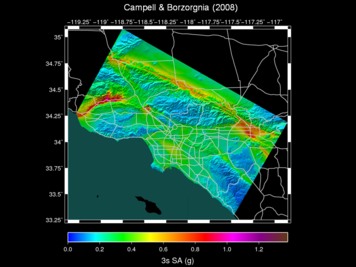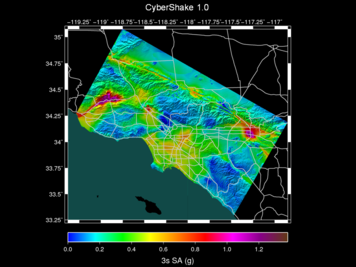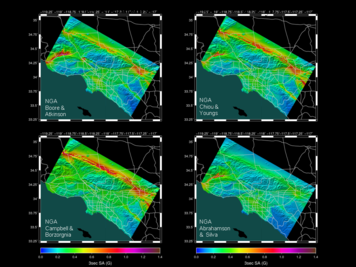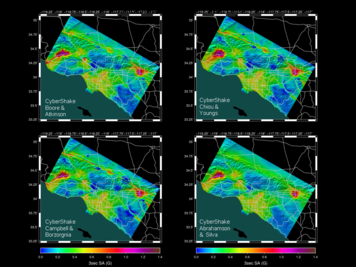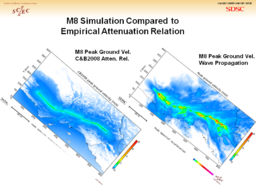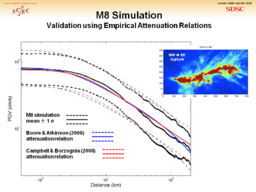Difference between revisions of "CyberShake"
| (5 intermediate revisions by 2 users not shown) | |||
| Line 1: | Line 1: | ||
CyberShake is a SCEC research project that is working to develop a physics-based computational approach to probabilistic seismic hazard analysis (PSHA). The CyberShake approach uses full 3D wave propagation simulations to forecast ground motions that will be produced by specific ruptures which is expected to produced significantly more accurate estimates for many sites than commonly used empirical-based ground motion decay attenuation relationships. | CyberShake is a SCEC research project that is working to develop a physics-based computational approach to probabilistic seismic hazard analysis (PSHA). The CyberShake approach uses full 3D wave propagation simulations to forecast ground motions that will be produced by specific ruptures which is expected to produced significantly more accurate estimates for many sites than commonly used empirical-based ground motion decay attenuation relationships. | ||
| − | This page details the scientific process and results of the CyberShake Project. For information about the software, please visit [CyberShake Training]. | + | This page details the scientific process and results of the CyberShake Project. For information about the software, please visit [[CyberShake Training]]. |
== Physics-based Probabilistic Seismic Hazard Analysis == | == Physics-based Probabilistic Seismic Hazard Analysis == | ||
| Line 26: | Line 26: | ||
As of April 2013, we moved the CyberShake Study numbering scheme to a Year.Month format based on date the simulations are started. | As of April 2013, we moved the CyberShake Study numbering scheme to a Year.Month format based on date the simulations are started. | ||
| − | *[[CyberShake Study | + | *[[CyberShake_Study_22.10]] |
| + | *[[Broadband_CyberShake_Validation]] | ||
| + | *[[CyberShake_BBP_Verification]] | ||
| + | *[[CyberShake Study 21.12]] | ||
*[[CyberShake Study 18.8]] | *[[CyberShake Study 18.8]] | ||
*[[CyberShake Study 17.3]] | *[[CyberShake Study 17.3]] | ||
Latest revision as of 20:39, 27 September 2022
CyberShake is a SCEC research project that is working to develop a physics-based computational approach to probabilistic seismic hazard analysis (PSHA). The CyberShake approach uses full 3D wave propagation simulations to forecast ground motions that will be produced by specific ruptures which is expected to produced significantly more accurate estimates for many sites than commonly used empirical-based ground motion decay attenuation relationships.
This page details the scientific process and results of the CyberShake Project. For information about the software, please visit CyberShake Training.
Contents
Physics-based Probabilistic Seismic Hazard Analysis
SCEC’s CyberShake project utilizes 3D simulations and finite-fault rupture descriptions to compute deterministic (scenario-based) and probabilistic seismic hazard in Southern California. Computational demands are intense, requiring parallel algorithms and high throughput workflows. Long period effects such as coupling of directivity and basin response that cannot be captured with standard approaches are clearly evident in the recently completed CyberShake 1.0 hazard map. Moreover, CyberShake allows for rapid recomputation of the hazard map to reflect short-term probability variations provided by operational earthquake forecasting. Going beyond traditional hazard analysis, event-specific phenomena can also be identified and analyzed through examination of the individual ground motion waveforms. This process highlights the importance of key elements in the Earthquake Rupture Forecast that are required by the simulation approach, including magnitude-rupture area scaling, aleatory and epistemic magnitude variability and spatio-temporal rupture characterization.
Computational PSHA
CyberShake is a computationally intensive way to improve standard probabilistic seismic hazard analysis. The CyberShake method for calculating long-term seismic hazard analysis is not yet the standard method for calculating long-term seismic hazards in the United States. The CyberShake computational technique has not been possible until recent improvements in 3D earth models, in 3D wave propagation software, in HPC computational resources, in large-scale workflows and data management. SCEC geoscientists are leading the scientific verification and validation of the CyberShake computational approach and SCEC/CME computer scientists are leading development of computational tools and techniques needed to implement the CyberShake calculations at the necessary scale. The CyberShake computational approach improves on standard PSHA calculations in a number of ways including:
- Wave propagation simulations more accurately describe the distribution of ground motions than the currently used ground motion prediction equations [GMPE].
- Wave propagation simulations provide good estimates of both ground motion amplitude as well as ground motion duration. Ground motion duration is not available from empirical peak ground motion methods.
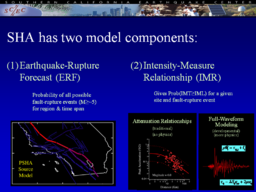 Fig 5: SCEC scientific software models probabilistic seismic hazard calculations using two main types of computational models (1) earthquake rupture forecasts and (2) intensity measure relationships. SCEC's OpenSHA software implementing earthquake rupture forecast models (including UCERF2.0 and planned UCERF3.0) and attenuation relationships. SCEC's CyberShake Project implements the most-advanced, and computationally-expensive, physics-based, full waveform modeling-based PSHA calculations. |
CyberShake Seismic Hazard Model Calculations
CyberShake calculations are performed using a number of different input confirmations, and computational software. SCEC reseachers define a calculation of interest as a Study. To qualify as a Study, the calculation needs to be clearly defined so we can calculate the types and volume of output data.
As of April 2013, we moved the CyberShake Study numbering scheme to a Year.Month format based on date the simulations are started.
- CyberShake_Study_22.10
- Broadband_CyberShake_Validation
- CyberShake_BBP_Verification
- CyberShake Study 21.12
- CyberShake Study 18.8
- CyberShake Study 17.3
- CyberShake Study 15.12
- CyberShake Study 15.4
- CyberShake Study 14.2
- CyberShake Study 13.4
Earlier CyberShake number Study numbers, not based on dates, are shown below.
- CyberShake Study 2.2
- CyberShake 2.0
- CyberShake 1.5
- CyberShake 1.4
- CyberShake 1.3
- CyberShake 1.2
- CyberShake 1.1
- CyberShake 1.0
Here is a comparison of CyberShake studies.
CyberShake Curves
- 1 Hz CyberShake Curves
- Comparison Curves
- Hybrid Deterministic/Stochastic Curves
- Fall 2011 Production Run Curves
Related Entries
- CyberShake Central California
- 2016 CyberShake database migration
- CyberShake output data formats
- CyberShake Source Filtering
- High Frequency CyberShake
- UCVM
- UCERF3.0
- CyberShake Workplan
- CyberShake SmartMap
- CyberShake Workflows
- CyberShake Computational Estimates
- UCERF3.0
- CyberShake SmartMap
- CyberShake Testing
- CyberShake Status
- CyberShake PBR
- SEISM Project
- Geoinformatics Project
- Accessing CyberShake Seismograms
- Accessing CyberShake Database Data
- First CyberShake Allocation Request (2005)
Reference
- Graves, R., Jordan, T.H., Callaghan, S. et al. CyberShake: A Physics-Based Seismic Hazard Model for Southern California. Pure Appl. Geophys. 168, 367–381 (2011). https://doi.org/10.1007/s00024-010-0161-6
